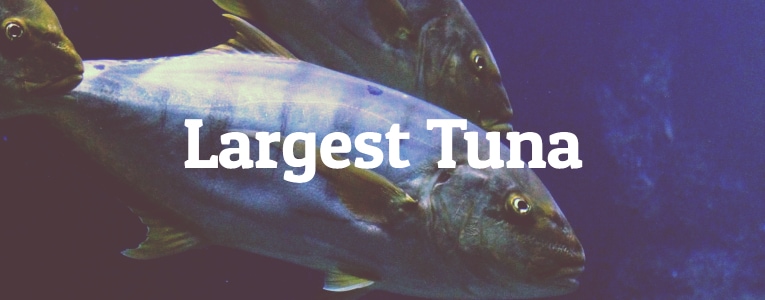Saltwater tuna is eaten worldwide. Many cuisines use tuna because of its taste and nutrients. Some tuna species are bigger and more valuable. Without naming it, we’ll examine the world’s biggest tuna species in this article.
Fast-swimming tuna may get large. Large tuna may weigh hundreds of pounds. Their delicious flesh and high omega-3 fatty acid content make them popular. Tuna migrate millions of kilometers across the ocean. They swim fast, making them one of the world’s most evasive fish. However, millions of tons of tuna are fished annually.
Commercial fisheries target the biggest tuna species. Sport fishermen also like catching large tuna.
Tuna is significant for more than size and taste. It’s also crucial to the ocean’s environment since sharks and billfish eat it. In addition, tuna help balance maritime ecosystems by controlling smaller fish and squid populations.
The biggest tuna species are praised for their size, taste, and nutrition. They’re hard to capture yet vital to the ocean’s ecology. These tuna species are wonderful, whether eaten or valued for their ecological importance. Now, here are the 8 largest tuna species in the world.
-
Blackfin
Approximate Weight: 45 lbs
Location: Eastern Coast of Americas
Conservation Status: Least Concern
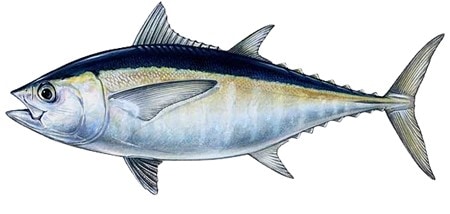 Source: Wikimedia
Source: Wikimedia
The Blackfin Tuna is the smallest species of Thunnus. This fish has a black oval body with some fading yellow towards the finlets and down its sides. It has a large dark stripe across the part of its eye.
It features an eye-catching yellow or gold lateral band that disappears after death. Its silver abdomen includes a series of vertical rows containing pale spots.
These migratory tuna are like the warm coastal waters of the Western Atlantic, where they form big schools with skipjack tuna and strain smaller fish, squid, and shrimp from the water.
They are torpedo-shaped and powerful swimmers.
-
Albacore
Approximate Weight: 130 lbs
Location: Atlantic, Pacific, and Indian Ocean
Conservation Status: Least Concern
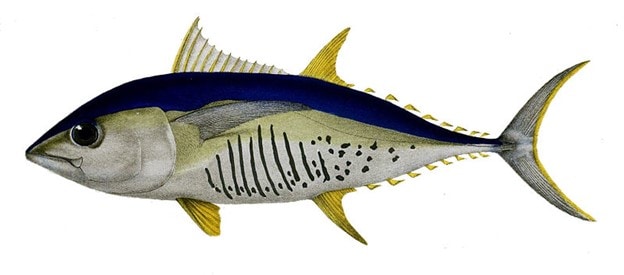 Source: Wikimedia
Source: Wikimedia
The Albacore is one of the most diminutive tuna species, with an adult size range that falls between the skipjack and the yellowfin.
They have the form of a bullet and a dark blue back, with lighter blue-gray sides and a lighter blue-gray belly.
They migrate over all of the oceans, including the Mediterranean, and prefer to travel in schools composed of only members of a single species. This prevents the amount of interbreeding that is found in other species.
Did You Know?
Also, albacore tunas have lengthy pectoral fins and may survive for around 12 years. As they age, albacore consumes less squid and a greater variety of fish, such as saury, lanternfish, and rockfish, in their diet.
-
Longtail
Approximate Weight: 80 lbs
Location: Australia
Conservation Status: Data Deficient
 Source: Wikimedia
Source: Wikimedia
The Longtail Tuna, commonly known as Northern Bluefin Tuna, belongs to the family Scombridae and other bluefin tuna species. These dark blue-backed fish are easily identifiable by their small pectoral fins and thin bodies.
Additionally, Longtail Tuna may be identified by elongated areas devoid of coloration on the belly and underside of the fish, located between the pectoral and anal fins.
The Longtail Tuna is a tropical fish that may be found throughout Australia’s east and west coastlines during the warmer summer months. These waters are located farther south. They are found across the waterways of northern Australia in their broad distribution.
Did You Know?
Comparable in appearance to the Southern Bluefin Tuna, but with a more streamlined body, especially the back half of the fish.
-
Yellowfin
Approximate Weight: 400 lbs
Location: Worldwide
Conservation Status: Least Concern
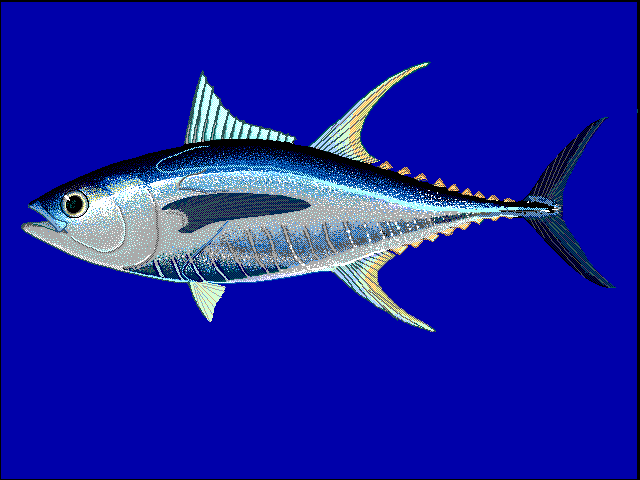 Source: Wikimedia
Source: Wikimedia
The yellowfin tuna is an important fisheries species worldwide since it is one of the quickest and fiercest predators in the open ocean. Yellowfin tuna is a huge fish that may grow at least 8 feet long and 400 pounds in weight (typically whole).
Individual yellowfin tunas are known to travel great distances each year during their annual migrations. Probably related to their spawning habits and food availability, these migrations occur at certain times of the year.
Broadcast spawning is this species’ reproductive strategy, in which several females and males simultaneously release millions of eggs and sperm into the water.
Did You Know?
Yellowfin tuna, like many bony fishes of the open ocean, develop from small larvae that are no more than a few millimeters long and weigh just a few hundredths of a gram.
-
Bigeye
Approximate Weight: 465 lbs
Location: Pacific, Atlantic, and Indian Oceans
Conservation Status: Vulnerable
 Source: Wikimedia
Source: Wikimedia
Bigeye tuna are often comparable to yellowfin tuna but are typically smaller than bluefin tuna. They have a metallic blue coloration on their backs and top sides, while their bottom sides and bellies seem almost white.
They are long and streamlined in appearance. They have a potential lifespan of up to 15 years. The tropical seas of the Pacific, Atlantic and Indian oceans are home to bigeye tuna.
Bigeye tuna are known to migrate great distances and are very mobile fish. They are a species that lives in the pelagic environment and may be found down to depths of 250 meters.
Did You Know?
In most cases, juveniles and sub-adults may be seen schooling at or close to the surface alongside other tuna species.
-
Southern Bluefin
Approximate Weight: 573 lbs
Location: Southern Hemisphere
Conservation Status: Endangered
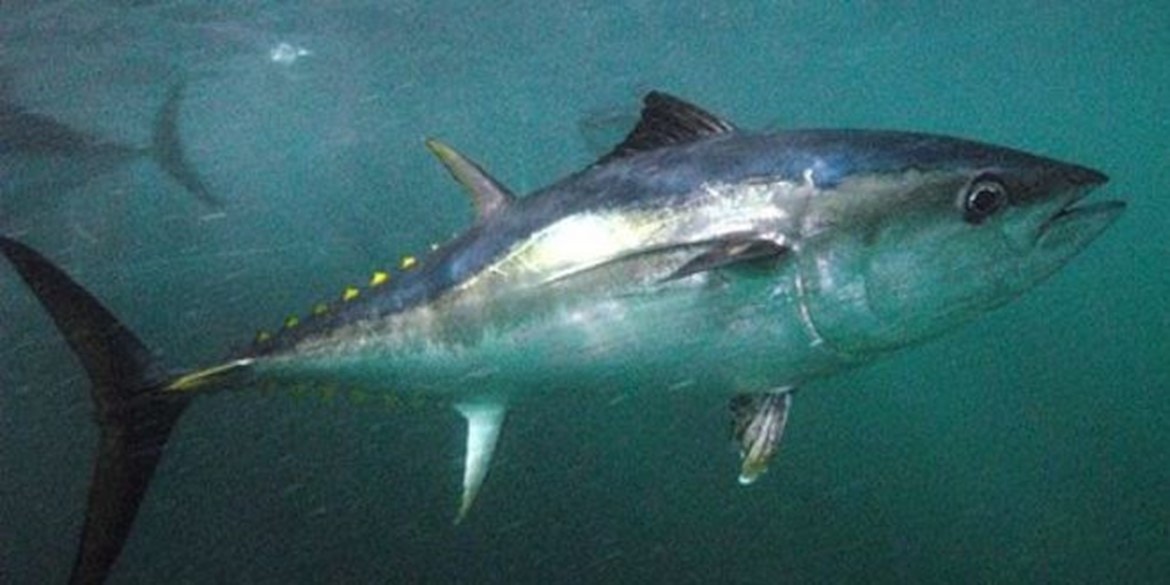 Source: Wikimedia
Source: Wikimedia
The southern bluefin tuna, scientifically known as Thunnus maccoyii, is a very big fish that is often collected by commercial long-liners from Indonesia and Japan in the Indian Ocean, which serves as their breeding habitat.
If a southern bluefin tuna is allowed to mature for around 12 years before it is captured, it can reach a length of 2.45 meters and a weight of up to 260 kilograms. These fish have swim bladders, and the underside of their bodies (known as the ventral side) has a silvery white tint.
Their first dorsal fin may be yellow or blue, depending on the species, and their anal fin and finlets have a dingy yellow base with a black edging. When adults, this portion of their caudal keel is yellow. They are denoted by dots of a corresponding color arranged in rows, in addition to colorless transverse lines.
Did You Know?
The lifespan of the huge pelagic species known as the southern bluefin tuna is estimated to be between 20 and 40 years.
-
Pacific Bluefin
Approximate Weight: 1000 lbs
Location: Northern Pacific Ocean
Conservation Status: Near Threatened
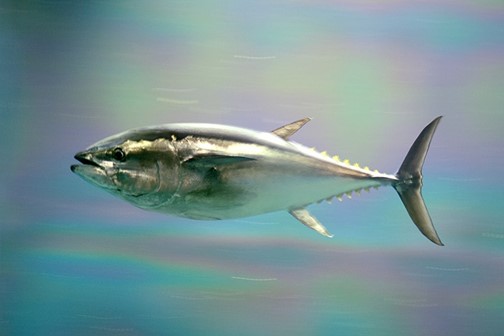 Source: Wikimedia
Source: Wikimedia
The Pacific bluefin tuna is a strong swimmer with a body designed for endurance and speed. This extremely migratory fish may travel thousands of kilometers in a stretch, crossing the Pacific Ocean in as little as fifty-five days to reach its breeding grounds.
During their migrations, bluefin tuna are known to swim across frosty northern seas and dive to depths of up to 1800 feet (550 meters) when the water temperature is below freezing.
In contrast to most other fish species, the bluefin tuna’s internal temperature may sometimes exceed the water it is swimming in.
Scientists have shown that this additional warmth promotes metabolic rates that are more effective, which in turn directly correlates to the tuna’s ability to swim quickly and powerfully.
Did You Know?
It is generally accepted that the Pacific bluefin tuna is a highly migratory species. Between the islands of Japan and the Philippines in the Western Pacific Ocean, they have their spawning grounds between April and August.
-
Atlantic Bluefin
Approximate Weight: 1,500 lbs
Location: Atlantic Ocean
Conservation Status: Threatened in Europe, Least Concerned elsewhere
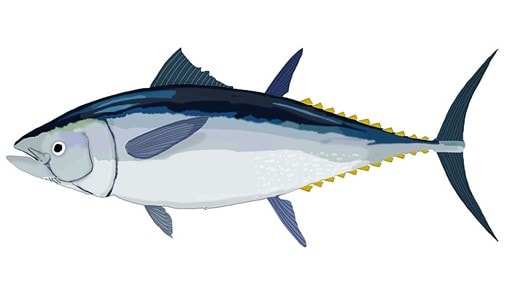 Source: Wikimedia
Source: Wikimedia
The Atlantic bluefin is the largest tuna species in the world. One of the fishes found all over the globe, the Atlantic bluefin tuna is notable for being one of the biggest, the quickest, and the most brilliantly colored. Their bodies are sleek and shaped like torpedoes, designed for speed and endurance.
As is the case with the majority of bony fishes that live in open oceans, Atlantic bluefin tuna begin their lives as incredibly small larvae that are no more than a few millimeters long and weigh no more than a few hundredths of a gram.
Warm-blooded fish are uncommon in the ocean, but Atlantic bluefin tuna have it, allowing them to thrive in a variety of environments, including the frigid waters off Newfoundland and Iceland, as well as the warm waters of the Gulf of Mexico and the Mediterranean Sea, where they travel annually to spawn.
Did You Know?
Individuals achieve their full length of three feet and sexual maturity between three to five years, depending on the species.
RELATED READINGS
10 Largest Fish In The World
12 Largest Freshwater Fish in the World
10 Largest Fish Ever Caught
7 Largest Catfish Ever Caught
5 Most Expensive Kinds of Tuna Available on the Market
